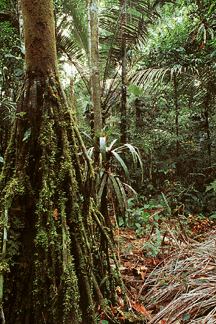Experience life in the trees at the Helen Brach Primate House
where groups of gibbons, tamarins and exotic lemurs make their home in an
indoor rain forest.
Opened in 1927, the historic Primate House was once lined with small
sterile cages typical of the early zoos. For more than 40 years this building
also was home to a succession of the zoo's gorilla patriarchs including
Bushman, Sinbad and Otto, all local celebrities
in their time. A two-year renovation completely transformed the old Primate
House into eight new naturalistic exhibits, replicating the native habitats
of the primates who make their home at Lincoln Park Zoo.
From the tiny emperor tamarins to the largest monkeys in the world,
mandrills, primates share many traits, including their most effective tool
for survival, a large brain. Remarkably agile as they swing from branch
to branch, primates are designed for their life in the forest. In fact,
humans are the only primates who have completely left the trees.
Long arms and a flexible skeleton make hand-over-hand travel, called brachiation,
an efficient and speedy way for most primates to get around, swinging through
the forest at up to 30 miles per hour. Refined hands and feet with nails
rather than claws help monkeys make a quick grab for treetop branches. Like
humans, many monkeys live in family groups and share not only social activities
like eating and grooming, they also cooperate with duties including child
care and protecting other members of the troop. |

| Howler monkeys, named for their booming calls, can be heard
miles away, emitting bellowing yowls that are often mistaken for thunder.
These noisy monkeys use their calls to locate each other, to claim and protect
their territory or to sound an alarm to the rest of their troop. Like many
of the animals in the Primate House, black howler monkeys are native to
tropical forests of South America where their diet of leaves, shoots and
insects is abundant year-round. |

 Sporting a glossy black coat with a white mantle over
its side and back and white rimming its face, black and white colobus
monkeys spend most of their time in the highest branches of the forest.
Subsisting on a diet heavy on leaves, these monkeys have a unique three-part
stomach that allows them to digest their fibrous diet. Native to tropical
forests and mountains of west central and east Africa, these monkeys live
in groups of three to 15. Sporting a glossy black coat with a white mantle over
its side and back and white rimming its face, black and white colobus
monkeys spend most of their time in the highest branches of the forest.
Subsisting on a diet heavy on leaves, these monkeys have a unique three-part
stomach that allows them to digest their fibrous diet. Native to tropical
forests and mountains of west central and east Africa, these monkeys live
in groups of three to 15.
Tops in aerial acrobatics, white-cheeked gibbons (pictured at
right==>)speed through the forest canopy, clearing 45-foot spans in a
single swing. Male and female gibbons are easily identifiable as males are
black with lighter cheeks and females are blonde, sometimes with dark patches.
Gibbons also add to the music of the trees with a haunting duet of calls
between the male and female, sung to claim their territory. Confrontations
at territorial boundaries are a frequent part of life for these endangered
primates native to tropical rainforests of southeast Asia and Indonesia.
Not all of the forest dwellers spend their time in the trees. Mandrills,
an Old World monkey, roam the ground on all fours. Troops of mandrills are
adept at fighting off predators and protecting their own. At night, they
do take refuge in the trees, resting comfortably on their tough rump pads.
These endangered primates are native to the forests of west central Africa
. Mandrills born at Lincoln Park Zoo have been placed in breeding groups
at zoo across the country.
Species Data Sheets:
|

 Tropical rainforests are disapearing
at an alarming rate. Local industries like timber production, agriculture
and mining are destroying the homes of forest-dwelling primates and other
animals. In fact, many populations are dwindling so fast it may not be long
before they are found only in isolated reserves, if at all. Tropical rainforests are disapearing
at an alarming rate. Local industries like timber production, agriculture
and mining are destroying the homes of forest-dwelling primates and other
animals. In fact, many populations are dwindling so fast it may not be long
before they are found only in isolated reserves, if at all.
More than 100 tropical species of monkeys are endangered
or threatened. Captive breeding and support from zoos provide some hope,
but are futile if the animals' native habitat is completely destroyed. Research
and conseravtion help in their native homes provide more hope. lincoln Park
Zoo participates in a global conservation program for howler monkeys and
has provided funding to help support a protected reserve for howlers in
the wilds of Belize.
 Ongoing research on emperor tamarin
behavior here at the zoo supports these endangered primates. Zoo-sponsored
fellowships have increased our knowledge of gibbons, lemurs and mandrills. Ongoing research on emperor tamarin
behavior here at the zoo supports these endangered primates. Zoo-sponsored
fellowships have increased our knowledge of gibbons, lemurs and mandrills.
Beyond research and conservation dollars, Lincoln
Park Zoo is working to teach the importance of preserving the earth's wild
places and the animals that inhabit them. With the spread of this message
is the hope that primates will be swinging through the trees of many tropical
forests for generations to come.
Top and bottom photos © Greg Neise
Middle photo © Thor Janson |


